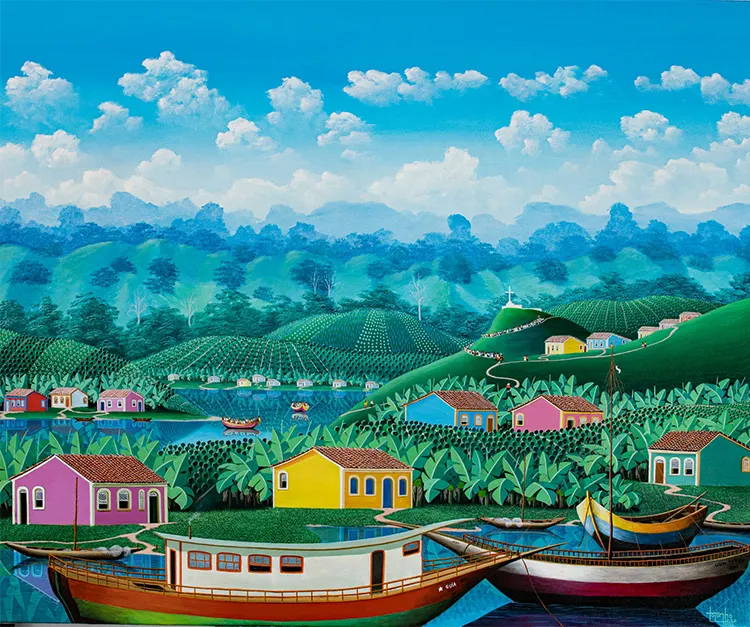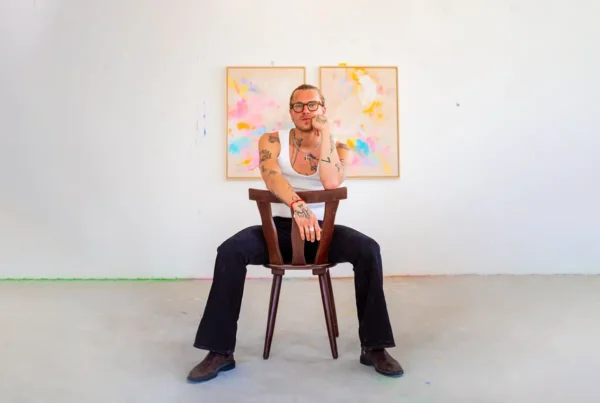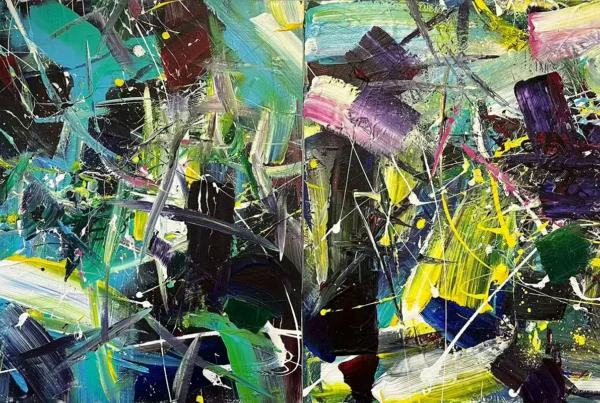“Fate decided for me. I was chosen to carry this bag full of letters that I have to deliver around the world.”
Roots in Bahia: The Genesis of an Artistic Vision
Brazilian artist Totonho was born in 1958 in the lush landscapes of the state of Bahia. This northeastern state, celebrated for its vibrant culture and natural beauty, shaped the artist’s profound connection to the environment. Totonho’s Afro-Indigenous heritage and early years on his grandparents’ farm—surrounded by dense rainforests, flowing rivers, and flocks of birds—planted the seeds of his artistic inclinations.
At merely three years old, he began drawing with charcoal on the walls of his home. These spontaneous creations, initially met with parental concern, soon earned admiration for their depth and storytelling. One of his earliest works depicted his father, a train driver, guiding a locomotive—an image that delighted his family and symbolized his burgeoning talent. Encouraged by their pride, Totonho was even gifted a wall to serve as his first artistic canvas. These humble beginnings mark the dawn of a lifelong journey in art, deeply rooted in the natural and familial surroundings of his childhood.
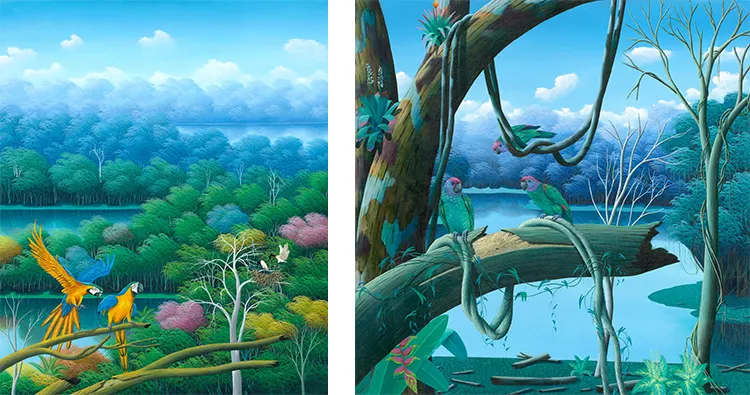
Cuidando com amor – 120 x 100 cm
A família – 80 x 80 cm
Totonho: Art as Life, Soul, and Responsibility
For Totonho, artistry is not merely a career or a choice but an innate calling—one he likens to being a messenger entrusted with sacred letters. This profound sense of purpose stems from his belief that art embodies his identity, spirituality, and sustenance. His parents and older brother played a pivotal role in nurturing his aspirations, offering unwavering support that allowed him to embrace his path wholeheartedly.
Throughout his career, Totonho has maintained an unshakable commitment to his craft. Describing art as his “mother, family, and religion,” he channels his experiences, emotions, and worldview into every stroke. His creative process is imbued with gratitude, resilience, and an acknowledgment of the privilege of artistic expression. Despite the challenges inherent in his journey, Totonho’s devotion to art has remained steadfast, driven by an unrelenting desire to translate his vision into visual narratives.
Nature dominates Totonho’s oeuvre, serving as both inspiration and subject matter. While human figures often subtly permeate his work, they are depicted as interlopers—agents of environmental disruption. His pieces critique the ecological degradation wrought by mankind, from deforestation and mining to river pollution and displacement of Indigenous communities. Through these themes, Totonho positions his art as a voice for both the voiceless and the endangered.
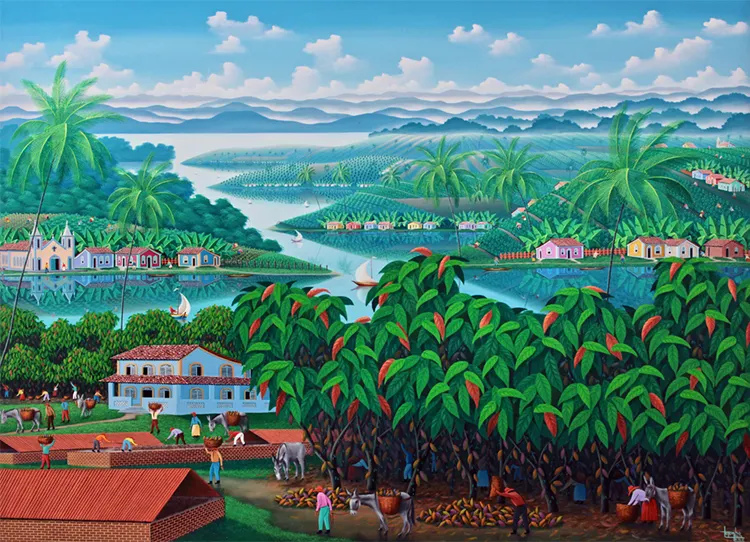
Fazenda chocolate – 190 x 140 cm
Portraits of Reality: Totonho’s Artistic Style and Influences
Totonho’s artistic style defies traditional classifications. As a self-taught artist, he prioritizes authentic expression over adherence to specific movements or techniques. His works exude raw emotion, focusing on the interplay between humanity and the natural world. Totonho’s choice of oil and acrylic paints reflects the practicality of his early access to materials, though he remains open to exploring new mediums.
Unlike many artists, Totonho did not grow up exposed to visual art but found his muse in music and literature. The poetic melodies of Louis Gonzaga and the vivid storytelling of Cordel literature shaped his early imagination. Later, musicians like Milton Nascimento and Belchior deepened his appreciation for art’s transformative power. These influences, though not visual in nature, resonate in Totonho’s ability to weave narrative depth into his paintings.
Among his most treasured works is “Pelourinho de Estrelas pelo Chão”, a poignant commentary on systemic neglect and lost potential. The piece symbolizes the tragedy of young talents thwarted by societal inequities. In contrast, he also draws inspiration from the work of Brazilian modernist Candido Portinari, particularly the iconic painting “Retirantes”. This piece depicts the plight of northeastern migrants in Brazil, mirroring Totonho’s own engagement with themes of struggle, resilience, and human dignity.
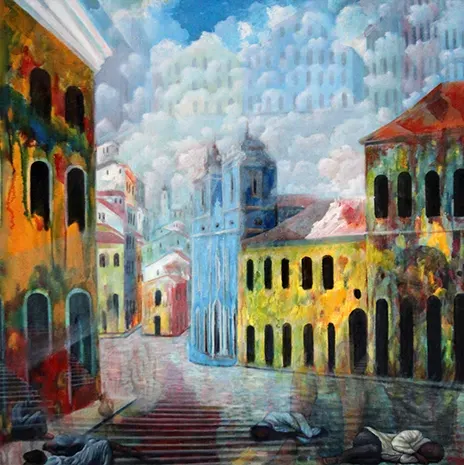
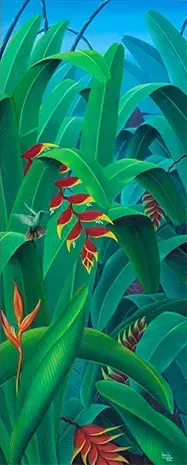
Pelourinho de estrelas pelo chão – 100 x 100 cm
No jardim lá de casa – 150 x 50 cm
Totonho: Dreams, Legacy, and the Power of Connection
Totonho’s creative sanctuary is a reflection of his artistic ethos. He surrounds himself with easels, canvases, and music, often retreating into the solitude of night to immerse himself in the act of creation. This focus enables him to channel his imagination without distraction, cultivating an environment where inspiration thrives.
One of Totonho’s dreams is to create a large-scale painting together with underprivileged children from various countries. An artwork that that culminates in a traveling exhibition, showcasing the unfiltered creativity of young minds. This project reflects his belief in art’s universal power to heal, empower, and inspire.
Totonho’s artistry transcends personal expression; it serves as a bridge between cultures, generations, and ecosystems. From the rainforest of Bahia to the global stage, his work invites viewers to reconsider their relationship with the natural world and their role within it. In every brushstroke, Totonho carries the echoes of his heritage, the wisdom of his upbringing, and the urgency of his message—a legacy of beauty and awareness that continues to ripple outward.
